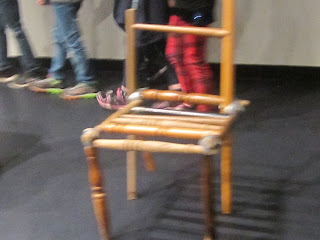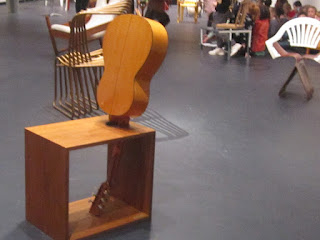Thursday, August 31, 2017
Music
We decided that it was too cold and rainy for syndicate sport today so spent the time exploring a couple of fun sites that you can create your own music on. We talked first about what we knew about music and looked at the different notes and timings. We noticed they were fractions and related it to what we learned yesterday with our paper folding exercise (see post below). Then we just played...
Check out these sites
Patatap
Incredibox
Check out these sites
Patatap
Incredibox
Sunday, August 27, 2017
Tuesday, August 15, 2017
Wednesday, August 9, 2017
Tuesday, August 8, 2017
Room 14's trip to te papa and 100 chairs in 100 days
Photos and writing by Ruben and Finlay
Last week room 14 went on a trip to Te papa and the city art gallery. We had tasks to complete at Te papa. We had to find the builder of the meeting house and we had to find treasure box's. Once we had finished our tasks we got free time to explore. Then we had lunch in bush city. After that mostly everyone walked to the city art gallery. When we arrived at 100 chairs in 100 days we had to figure out what some of the chairs were called. We had to draw our favourite chair and how we think it would move and what sond it would make. Here are some pictures of the chairs
Show not tell sentences
This term we are creating exciting narratives to entertain our readers. To do this we need to make sure that we are writing 'show not tell' sentences. This is what room 14 think that means:
We need to use description
We need to use dialogue
We have to focus on the important parts and remove boring parts
We should give our reader clues
We need to make our reader visualise
We should use powerful verbs
Our reader has to infer (do a bit of work)
We practised this today with our learning buddies. First, we came up with some emotions and then we had to write a sentence with our buddy on a post it note that would show, not tell, our reader how a character was feeling.
Here are some of our show, not tell sentences.
We need to use description
We need to use dialogue
We have to focus on the important parts and remove boring parts
We should give our reader clues
We need to make our reader visualise
We should use powerful verbs
Our reader has to infer (do a bit of work)
We practised this today with our learning buddies. First, we came up with some emotions and then we had to write a sentence with our buddy on a post it note that would show, not tell, our reader how a character was feeling.
Sunday, August 6, 2017
Martino Gamper Collage
As a follow up to our trip to see Martino Gamper's exhibition 100 Chairs in 100 Days we had to deconstruct and reconstruct our own chairs. Well, paper copies. We thought about the ways in which we could deconstruct the chairs and the ways in which we could reconstruct. We thought about how we could put opposing things together like Martino Gamper does. Ugly/beautiful, soft/hard, simple/complex etc. Lots of divergent thinking happening.
Science - Super Senses
This week we have kicked off by exploring our senses - particularly touch, smell, sight and taste.
Smell and taste
We did an experiment using jelly beans where we were blindfolded and had to guess the colour based on smell and taste. Here is some of our thinking about that experiment.
Is it easier to recognise the jellybean by smell or taste?
7 people got them all correct for smell and taste
8 people found it easier to recognise by smell
2 person found it easier to recognise by taste
1 person got the same in smell and taste
We can conclude that we know our jelly beans quite well! We think that overall it is easier to recognise jelly bean's flavour/colour by its smell.
How can sight impact taste?
Sam looked at the yellow jelly bean and smelled it and thought it would taste like banana. Our brain can think that yellow means banana so that is what we taste (it is actually pineapple). The mind can play tricks on you.
Touch
We then had to use callipers to touch using either one point or two points on different body parts. The callipers were set at different widths. We had to do each spot 3 times with one point and 3 times with two points. Here is some of our thinking about touch.
Why do we need to do each spot 3 times?
If you only had one turn you wouldn't get as much data. We might get more accurate results.
Which parts of the body are most sensitive?
Cheek
Inner arm
Palm of hand
Sole of foot
What evidence have you used to judge this?
Because Aviah said 'ow' a lot
Because William could feel it hard although Ruben put it on lightly
There were the most ticks which means your body can feel the points more
What advantages might there be for these areas to be sensitive to touch?
We use our palms to feel things. Our feet should be sensitive so we can feel if there is something down beneath us. Hands and feet are the parts of our body that will touch things first so it keeps us safe.
There were also some scent bottles that we had to match up and recognise different smells and some optical illusions to explore.
Smell and taste
We did an experiment using jelly beans where we were blindfolded and had to guess the colour based on smell and taste. Here is some of our thinking about that experiment.
Is it easier to recognise the jellybean by smell or taste?
7 people got them all correct for smell and taste
8 people found it easier to recognise by smell
2 person found it easier to recognise by taste
1 person got the same in smell and taste
We can conclude that we know our jelly beans quite well! We think that overall it is easier to recognise jelly bean's flavour/colour by its smell.
How can sight impact taste?
Sam looked at the yellow jelly bean and smelled it and thought it would taste like banana. Our brain can think that yellow means banana so that is what we taste (it is actually pineapple). The mind can play tricks on you.
Touch
We then had to use callipers to touch using either one point or two points on different body parts. The callipers were set at different widths. We had to do each spot 3 times with one point and 3 times with two points. Here is some of our thinking about touch.
Why do we need to do each spot 3 times?
If you only had one turn you wouldn't get as much data. We might get more accurate results.
Which parts of the body are most sensitive?
Cheek
Inner arm
Palm of hand
Sole of foot
What evidence have you used to judge this?
Because Aviah said 'ow' a lot
Because William could feel it hard although Ruben put it on lightly
There were the most ticks which means your body can feel the points more
What advantages might there be for these areas to be sensitive to touch?
We use our palms to feel things. Our feet should be sensitive so we can feel if there is something down beneath us. Hands and feet are the parts of our body that will touch things first so it keeps us safe.
There were also some scent bottles that we had to match up and recognise different smells and some optical illusions to explore.
Thursday, August 3, 2017
Subscribe to:
Comments (Atom)



















